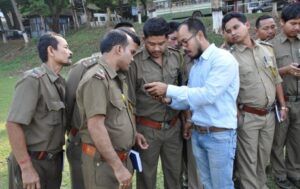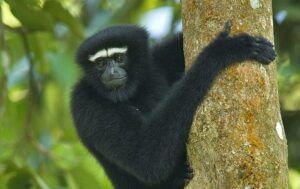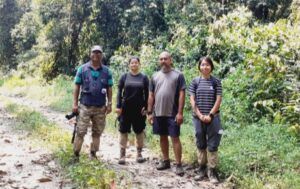Hoolock gibbons and
golden langurs
Partner profile

Scientists: Dr. Jihosuo Biswas
Nationality: Indian
Organisation: Conservation Himalayas/Primate Research Centre NE India
How PTES has helped me so far:
People’s Trust for Endangered Species (PTES) has been supporting my work on Western hoolock gibbons since 2011 and on golden langurs since 2021, as well as providing funding for me to attend important meetings and conferences overseas.

My journey
After studying Zoology at University, I started a Masters in Entomology and Environmental Biology, however an encounter with a Hoolock gibbon during a field trip in 1995 had a profound impact on me and I decided to instead focus my studies on gibbons. A visit in 1996 to the small river island of Umananda in Guwahati, the capital of Assam to study a family of gibbons that has been released there introduced me to golden langurs. I found that the gibbons had unfortunately died after facing fierce competition from the golden langurs who had also been released there. It underscored the challenges that can happen when species with distinct ecological niches are forced into proximity. After completing my master’s, I joined the Indo-US Primate Project as a Junior Research Fellow and completed my PhD on golden langur ecology and social behaviour. I joined the Primate Research Centre in 2004 where my focus has been on golden langur and hoolock gibbon research and conservation.

Why I love these species
My home is within the range of golden langurs, which are found only in four districts of Assam in India, and six districts of Bhutan. My affection for this species is deeply rooted as I grew up observing them from childhood. Golden langurs are not only gorgeous, charming, and harmless but also hold a special place in my heart. So, I decided to pursue my PhD on golden langur ecology and social behaviour despite facing many hardships during tumultuous times of social unrest in lower Assam.
Similarly, Hoolock gibbons, an iconic species and champion of the forest canopy, embodies the legacy of Indian cultural heritage. Both species are symbols of our rich natural and cultural history, and their conservation is of utmost importance.

My goal
As a primatologist, my goal is to study and manage primate populations in northeast India and their habitats to ensure the conservation and sustainability of ecosystems and the species within them.

What your donation can achieve
£25
could help plant saplings to restore natural corridors of forest, providing new safe routes through the landscape.
£50
could help the team to manage and maintain artificial canopy bridges installed across roads and villages.
£100
could allow the team to train forest rangers on primate conservation and monitoring.
